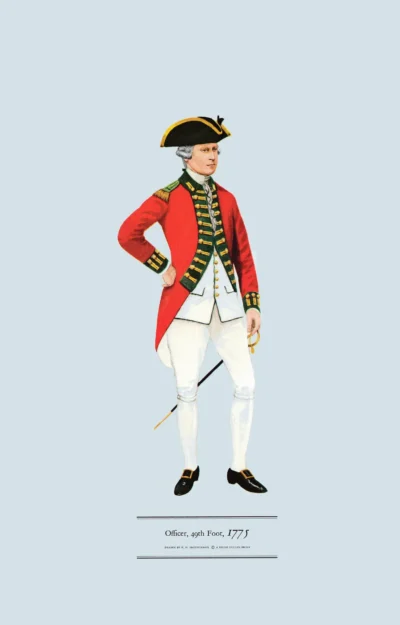Officer, 49th Foot, 1775 (The Berkshire Regiment)
Original price was: £15.00.£15.00Current price is: £15.00.
The Hertfordshire Regiment of Foot merged with The Royal Berkshire Regiment in 1881 which merged into The Rifles in 2007 (scroll down for a more detailed Description)
Published 1965 by © Hugh Evelyn Limited; drawn by Colonel Philip Henry Smitherman (1910-1982), Royal Corps of Signals
Size: c. 24.5 x 37.5 cm [9 ½ ″ x 14 ½ ″] (may vary slightly from printers’ cut 50 years ago)
Printed on on medium cardstock weighing 144 g/sm2 faced in light greyish blue (RGB c. d4e1e8)
Print is STANDARD size – shipping is the same for 1 to 10 prints (based on largest print size in your order) – see Shipping & Returns.
In stock
Description
The 49th was raised by Edward Trelawney, Governor of Jamaica, in 1743 becoming the 49th (Princess Charlotte of Wales’s) (Hertfordshire) Regiment in 1816. The Childers Reforms merged this with the Royal Berkshire Regiment in 1881. They saw service in the Boer War and both World Wars. In 1959 it amalgamated with the Wiltshire Regiment to form the Duke of Edinburgh’s Royal Regiment (Berkshire and Wiltshire). In 1994 this became the Royal Gloucestershire, Berkshire and Wiltshire Regiment. In 2007 it joined the Devonshire and Dorsets, the Green Jackets and The Light Infantry to form The Rifles. The green facings changed to white in 1881 and later to blue. Based on a coat in the National Army Museum, the garment shown here is neat and elegant. The shoulder cords have become a fringed strap and denote rank and function. Grenadier officers and field officers wore an epaulette on each shoulder; officers of battalion companies wore one only on the right shoulder. The coat and portrait are contemporary, so officers may still have had some latitude in dress. The hat is shown still cocked in the old fashion, which was rapidly disappearing. The way hats were cocked followed civilian fashion. Officers cocked their hats this way and regulations eventually caught up with fashion. This officer is in undress uniform so wears silk stockings and shoes. On duty he would wear boots, black gaiters, a crimson sash round his waist and a shoulder belt for his sword over his right shoulder. He should have worn a gilt gorget according to regulation, but this regulation was often ignored.
Additional information
| Weight | 0.0131 kg |
|---|---|
| Dimensions | 23 × 37 cm |





